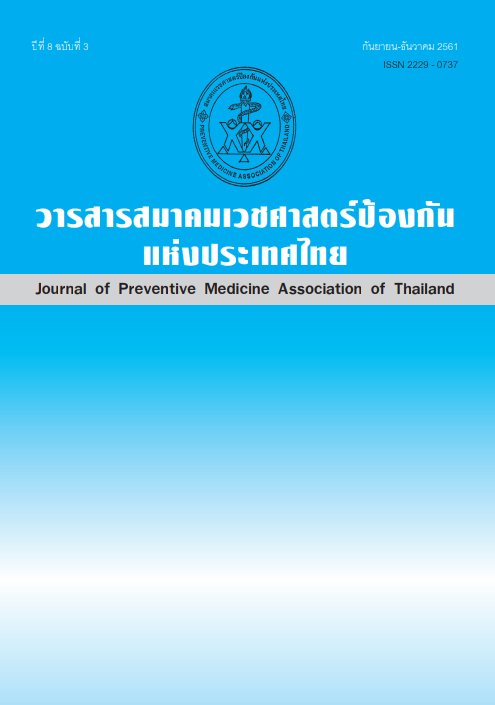Appropriate Use of Antibiotics in Ranong Province: A Stepwise Approach to Rational Drug Use
Keywords:
Rational Drug Use, AntibioticAbstract
Irrational use of antibiotics is a global problem contributing to the development of resistance of microorganisms to standard treatments with increased morbidity and mortality rates. Rational drug use policy and guideline manual have been implemented by the Ministry of Public Health of Thailand since 2017. The objective of this study was to evaluate the impact of the implemented policy on antibiotic prescription, and in addition, the healthcare expenditure on antibiotic usage in the five main hospitals in Ranong Province. Four infectious diseases were focused in the study, i.e.,upper respiratory tract infection and acute bronchitis, acute diarrhea, fresh traumatic wound, and antibiotic prophylaxis in vaginal delivery of normal term labor. Relevant information on antibiotics use in the four focused diseases were collected by healthcare personnel from the electronic databases of the five focused hospitals. Multifaceted interventions were implemented to promote appropriate use of antibiotics in all relevant partners. After policy implementation, the average rates of antibiotics prescribed in all of the four target diseases have been continuously decreased from 2016 to 2018. The prescription rates in acute diarrhea and prophylaxis use in vaginal delivery of normal term labor were found to be significantly decreased below the target levels (20%). The daily doses (DDDs) of oral antibiotics prescribed in out-patients per1,000 visit perday and the daily doses (DDDs) of injectable antibiotics use in in-patients per100 patients-bed day as well as average cost of antibiotics use (per month) were generally decreased continuously. The key factors contributing to successful implementation of appropriate antibiotic use were promotion of awareness and provision of education and training of physicians, healthcare personnel, patients and communities as well as close monitoring and evaluation of the implemented program.
References
2. Zellweger RM, Carrique-Mas J, Limmathurotsakul D, Day NPJ, Thwaites GE, Baker S. A current perspective on antimicrobial resistance in Southeast Asia. J Antimicrob Chemother 2017;72:2963-2972.
3. Kourkouta L, Kotsiftopoulos CH, Papageorgiou M, Iliadis CH, Monios A. The rational use of antibiotics medicine. J Healthc Commun 2017;2(3):1-4.
4. World Health Organization (WHO). ATC/DDD Index [Internet] 2018. [Cited 2018 Aug 24] Available from: https://www.whocc.no/ddd/definition_and_general_considera/
5. Gunawardhana CB, Sakeena MHF, Sivayoganthan C. Awareness of rational medication use and antibiotic self medication practices among undergraduate students in a university in Sri Lanka. Trop J Pharm Res 2015;14(4):723-729.
6. Holloway KA. Promoting the rational use of antibiotics. Regional Health Forum. 2011; 15:122-130.
7. Sumpradit N, Chongtrakul P, Anuwong K, Pumtong S, Kongsomboon K, Butdeemee P, et al. Antibiotics smart use: a workable model for promoting the rational use of medicines in Thailand. Bull World Health Organ 2012;90:905-913.
8. Bbosa GS, Wong G, Kyegombe DB, Ogwal-Okeng J. Effects of intervention measures on irrational antibiotics/antibacterial drug use in developing countries: A systematic review. Health 2014; 6:171-187.
9. Arnold SR, Straus SE. Interventions to improve antibiotic prescribing practices in ambulatory care. Cochrane Database Syst Rev 2005;4:CD003539.
10. Boonyasiri A, Thamlikitkul V. Effectiveness of multifaceted interventions on rational use of antibiotics for patients with upper respiratory tract infections and acute diarrhea. J Med Assoc Thai 2014;97 (Suppl. 3):S13-S19.
11. Sirijatuphat R, Choochan T, Siritongtaworn P, Sripojtham V, Thamlikitkul V. Implementation of antibiotic use guidelines for fresh traumatic wound at Siriraj Hospital. J Med Assoc Thai 2015;98(3):245-252.
12. Bonet M, Ota E, Chibueze CE, Oladapo OT. Routine antibiotic prophylaxis after normal vaginal birth for reducing maternal infectious morbidity. Cochrane Database of Systematic Reviews 2017; Issue 11. Art. No.: CD012137.
Downloads
Published
How to Cite
Issue
Section
License
บทความที่ลงพิมพ์ในวารสารเวชศาสตร์ป้องกันแห่งประเทศไทย ถือเป็นผลงานวิชาการ งานวิจัย วิเคราะห์ วิจารณ์ เป็นความเห็นส่วนตัวของผู้นิพนธ์ กองบรรณาธิการไม่จำเป็นต้องเห็นด้วยเสมอไปและผู้นิพนธ์จะต้องรับผิดชอบต่อบทความของตนเอง






